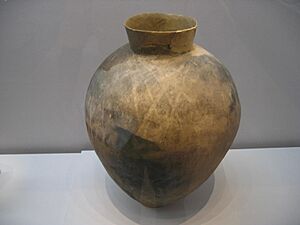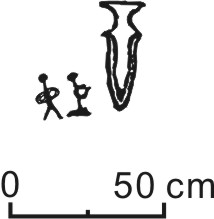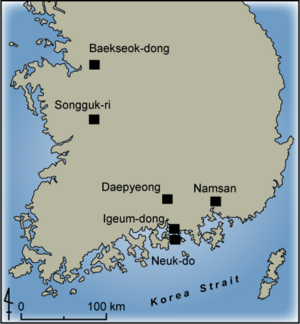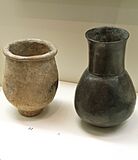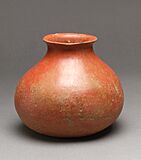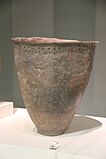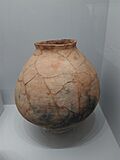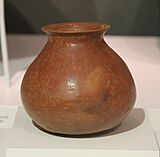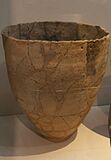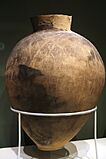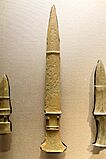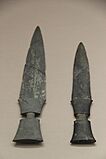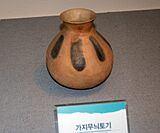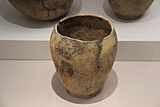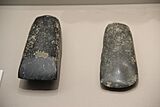Mumun pottery period facts for kids
| Geographical range | Korean peninsula |
|---|---|
| Period | Late Stone Age , Bronze Age |
| Dates | c. 1500 – c. 300 BC |
| Preceded by | Jeulmun pottery period |
| Korean name | |
| Hangul |
무문토기시대
|
| Hanja |
無文土器時代
|
| Revised Romanization | Mumun togi sidae |
| McCune–Reischauer | Mumun t'ogi sidae |
The Mumun pottery period was an important time in ancient Korean history. It lasted from about 1500 BC to 300 BC. This period is named after the Korean word for "undecorated" or "plain" pottery. These simple cooking and storage pots were very common throughout this time.
The Mumun period is known as the time when serious farming began in Korea and Japan. Societies also started to become more complex. Sometimes, people call this time the "Korean Bronze Age". However, this name can be a bit confusing. Bronze tools were not made in Korea until much later, around 800 BC. Also, bronze items were quite rare and only found in certain areas until after 300 BC.
Archaeologists have learned a lot about the Mumun Period since the 1990s. Many new sites have been dug up. This has greatly increased our understanding of this key time in East Asian history.
Before the Mumun period, there was the Jeulmun Pottery Period (about 8000-1500 BC). During the Jeulmun period, people mostly hunted, gathered food, and did a little bit of farming. The Mumun period began when people who used Mumun pottery and practiced "slash-and-burn" farming moved into areas. They replaced the older Jeulmun ways of life. Large settlements, Mumun pottery, and huge stone burials (megaliths) found in the Liao River Basin and North Korea suggest where the Mumun period in Southern Korea might have started.
Contents
A Look at the Mumun Period
Early Mumun: Starting Out
The Early Mumun period (about 1500-850 BC) was a time of change. People moved around, doing "shifting cultivation" (a type of farming). They also fished and hunted for food. Settlements were small, with rectangular houses dug partly into the ground.
At first, everyone in society was pretty equal. But later in this period, groups started to compete more. Some people might have become part-time leaders, like "big-men." Many Early Mumun settlements were found in the river valleys of West-central Korea. One of the biggest was Eoeun, in South-central Korea. Later, very large settlements with many long-houses appeared, like Baekseok-dong near modern Cheonan City.
Important traditions began during this time. These include building huge stone tombs called megalithic burials. People also started making red-burnished pottery and polished stone daggers.
Middle Mumun: Growing Stronger

The Middle Mumun period (about 850-550 BC) saw a big increase in farming. At a large settlement called Daepyeong, archaeologists found huge dry-field farms. This settlement was very big, with many houses and ditches around it. It also showed signs of specialized work and early leaders. People also started growing rice in wet fields, called paddy fields, in southern Korea.
Some burials from the later Middle Mumun (about 700-550 BC) had special items. These included rare bronze objects, showing that bronze making probably began in Southern Korea around this time. Other important burials had greenstone (or jade) jewelry. Many large stone tombs were built near the southern coast. These tombs had deep burial shafts and valuable items like bronze daggers, jade, and red pottery.
Large buildings and important tombs at sites like Deokcheon-ni and Igeum-dong site show that some people were becoming more powerful. Societies were starting to look like simple "chiefdoms," where a leader had control over a group of villages.
Korean archaeologists sometimes call the Middle Mumun culture the Songguk-ri Culture. This culture is found in many places across southern Korea, including Jeju Island and even western Japan.
The Mumun culture started a long tradition of rice farming in Korea that continues today. However, in the Early and Middle Mumun, rice was not the only crop. People also grew millets, barley, wheat, and beans. They still hunted and fished too.
Late Mumun: Facing Challenges
The Late Mumun period (550-300 BC) was a time of more conflict. People started living in fortified settlements on hilltops. More people gathered in larger settlements, especially along the southern coast. For example, at the Namsan settlement in modern Changwon City, houses were inside a huge ditch, 4.2 meters deep and 10 meters wide. This strong defense suggests that groups might have been fighting each other.
There were fewer settlements in the Late Mumun than before. This means people likely moved and gathered into a smaller number of bigger villages. This could have happened because of more conflict or changes in the climate that caused crops to fail.
Around this time, settlements similar to Mumun ones appeared in Northern Kyūshū (Japan). The Mumun period ended when iron tools started to appear in the archaeological record. Also, houses changed to have indoor hearths, like the agungi seen in later Korean history.
Some experts think the Mumun period should last until about 0 BC. This is because a plain pottery called jeomtodae was popular until then. However, after 300 BC, bronze became very important for ceremonies and leaders. Also, iron tools became more common in Southern Korea. These changes show that the time after 300 BC was very different from the Mumun pottery period. So, the Mumun period is usually considered to end around 300 BC.
After 300 BC, bronze items were the most prized possessions in burials. Iron tools were also traded and then made in the Korean peninsula. At the Neuk-do Island Shellmidden Site, archaeologists found some iron objects, along with pottery from Lelang and Yayoi cultures. This shows that during the Late Mumun, local societies started to have closer connections with groups from the Late Zhou Dynasty, Final Jōmon, and Early Yayoi periods.
Mumun Cultural Traits
The Mumun culture had several key features:
Languages
Some scholars believe that Japonic languages were spoken in parts of the Korean Peninsula before Koreanic speakers arrived. It's thought that Japonic languages came to Korea around 1500 BC. Then, they were brought to Japan by Yayoi rice farmers between 700-300 BC. Some linguists think that Koreanic speakers arrived in Korea after the Japonic speakers. They might have lived alongside them and possibly mixed with them. Both Koreanic and Japonic languages influenced each other over a long time.
How People Lived
- In the Early Mumun, people got food in many ways. They hunted, fished, gathered wild plants, and also farmed.
- Stone tools for farming were common. These included special semi-lunar blades.
- By the Middle Mumun, intensive wet-field farming (paddy farming) was happening. Even so, people still hunted and fished to some extent.
Settlements and Homes
- Early Mumun homes were large, rectangular pit-houses. They had one or more fireplaces. Some houses had up to six fireplaces, suggesting that several generations of a family lived together.
- After about 900 BC, houses became smaller. They were square, circular, or oval. They didn't have fireplaces inside. Instead, they had a shallow oval "work-pit" in the middle of the floor.
- Archaeologists think this change in house style shows a social shift. Families might have changed from large, multi-generational groups living together to smaller groups of independent nuclear families living in separate houses.
- Most Mumun settlements were small. However, some in the Middle Mumun grew to have hundreds of houses.
Economy and Trade
- Most goods were made by individual households. But in the Middle Mumun, some people started making specialized crafts. There was also a "big-man" system where leaders might collect and then share goods.
- Archaeologists have found signs that people produced extra crops, stone tools, and pottery in the Middle Mumun.
- Items like greenstone ornaments, bronze objects, and certain red pottery were traded. This shows there were regional trade networks.
Burial Customs
- People used different types of burials. These included huge stone tombs (megalithic burials), stone-lined graves, and jar burials.
- Some burials in the later Middle Mumun were very large. They needed a lot of work to build. A few Middle Mumun burials contained valuable or ceremonial items. These included bronze, greenstone, polished stone daggers, and red-burnished pottery.
Gallery
See also
- List of archaeological periods - a list of ancient time periods
- Prehistoric Korea - more about ancient Korea
- Liaoning bronze dagger culture - another ancient culture known for bronze daggers


